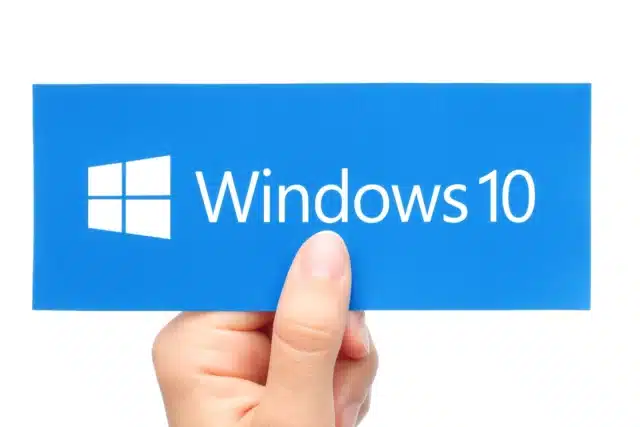
It’s the time of the month when Microsoft releases its latest preview updates for Windows 10 and 11 and, sure enough, we have the preview version of the KB5034203 update for Windows 10.
This cumulative update addresses a number of issues including problems with printers, and it also lays the groundwork for the arrival of a “richer weather experience” on the lock screen. It is not long since the last problematic update for Windows 10, and while the KB5034203 update does not (yet) appear to introduce any new issues, some familiar problems persist.
Microsoft points to just a couple of highlights in this release, the first of which sees a fix for an issue that caused some single-function printers to install as scanners. More interesting, and continuing to run counter to the company’s previous pledge that nothing new would now be added to Windows 10, the update makes improvements to the lock screen as Microsoft explains:
New! The coming weeks will bring a richer weather experience to your lock screen. This includes dynamic, interactive weather updates. So, as you hover over the weather on your lock screen, you will see more information. When you tap or click on the weather card and sign in, Microsoft Edge opens with the full forecast in MSN weather. If you already use Weather in Settings > Personalization > lock screen > Lock screen status, there is nothing for you to do. Also, this new experience will be on by default if Lock screen status is set to “None”. Like today, lock screen status will be available when you lock your screen no matter which personalization option you select (Windows spotlight, Picture, or Slideshow).
The full changelog looks like this:
- Microsoft has been working to ensure compliance with the Digital Markets Act (DMA) in the European Economic Area (EEA). To learn more, see Previewing changes in Windows to comply with the Digital Markets Act in the European Economic Area. These changes will gradually roll out to Windows 10, version 22H2 PCs in the EEA to be compliant by March 6, 2024.
- This update addresses an issue that affects an Internet Explorer shortcut. After you use a policy to remove it, the shortcut reappears.
- This update addresses an issue that affects Windows Management Instrumentation (WMI). A caching issue occurs. The issue causes CurrentTimeZone to change to the wrong value.
- This update addresses an issue that affects XPath queries on FileHash and other binary fields. It stops them from matching values in event records.
- This update addresses a known issue that affects BitLocker data-only encryption. A mobile device management (MDM) service, such as Microsoft Intune, might not get the right data. This occurs when you use the FixedDrivesEncryptionType or SystemDrivesEncryptionType policy settings in the BitLocker configuration service provider (CSP) node.
- This update addresses an issue that affects the Code Integrity Module (ci.dll). This issue stops your device from responding.
- This update includes quarterly changes to the Windows Kernel Vulnerable Driver Blocklist file, DriverSiPolicy.p7b. It adds to the list of drivers that are at risk for Bring Your Own Vulnerable Driver (BYOVD) attacks.
- This update affects Unified Extensible Firmware Interface (UEFI) Secure Boot systems. It adds a renewed signing certificate to the Secure Boot DB variable. You can now opt for this change.
- This update addresses an issue that stops you from reconnecting to an existing Remote Desktop session. Instead, you get a new one.
- This update addresses an issue that occurs when you change the keyboard language. The change fails to apply to RemoteApps in some scenarios.
- This update addresses an issue that affects Windows Local Administrator Password Solution (LAPS) Post Authentication Actions (PAA). The actions occur at restart instead of at the end of the grace period.
- This update addresses an issue that affects Active Directory. Bind requests to IPv6 addresses fail. This occurs when the requestor is not joined to a domain.
- This update addresses an issue that affects the LocalUsersAndGroups CSP. It stops processing group memberships if it cannot find a group.
- This update addresses an issue that affects deleted cloud files. When a cloud provider vetoes a deletion request, the files might still be removed.
- This update addresses an issue that affects MSIX applications. They do not open, and, in some cases, they make the host unresponsive. This occurs when they use MSIX App Attach with a CimFS image.
- This update addresses an issue that affects Group Policy Folder Redirection in a multi-forest deployment. The issue stops you from choosing a group account from the target domain. Because of this, you cannot apply advanced folder redirection settings to that domain. This issue occurs when the target domain has a one-way trust with the domain of the admin user. This issue affects all Enhanced Security Admin Environment (ESAE), Hardened Forests (HF) or Privileged Access Management (PAM) deployments.
- This update changes a setting in Active Directory Users & Computers. By default, the snap-in now uses a strong certificate mapping of X509IssuerSerialNumber. It does not use the weak mapping of x509IssuerSubject.
As for the problems that still remain, Microsoft concedes that an issue that causes desktop icons to rearrange on some multi-monitor systems still plagues users. On top of this, there is the warning that if you have moved the Windows 10 taskbar to the left or right of the screen, Copilot in Windows will not work.
If you would like to install the KB5034203 update, you can check for optional updates or download it from the Microsoft Update Catalog.
Image credit: rozelt / depositphotos
